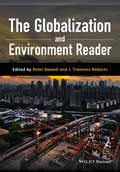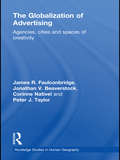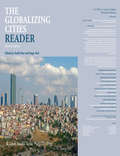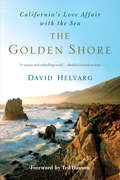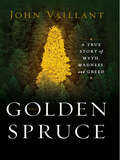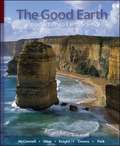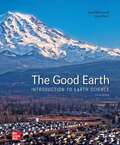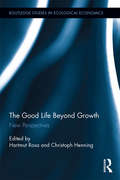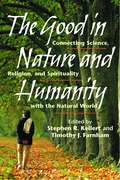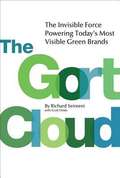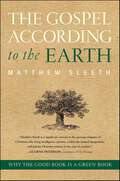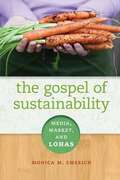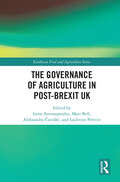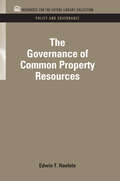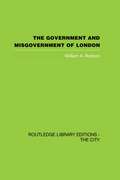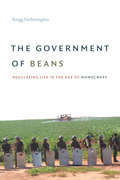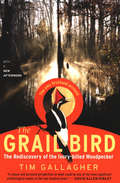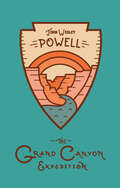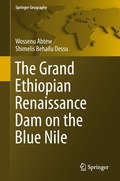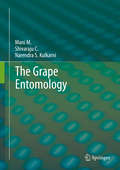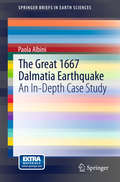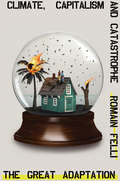- Table View
- List View
The Globalization and Environment Reader
by Peter Newell J. Timmons RobertsThe Globalization and Environment Reader features a collection of classic and cutting-edge readings that explore whether and how globalization can be made compatible with sustainable development. Offers a comprehensive collection of nearly 30 classic and cutting-edge readings spanning a broad range of perspectives within this increasingly important field Addresses the question of whether economic globalization is the prime cause of the destruction of the global environment - or if some forms of globalization could help to address global environmental problems Features carefully edited extracts selected both for their importance and their accessibility Covers a variety of topics such as the 'marketization' of nature, debates about managing and governing the relationship between globalization and the environment, and discussions about whether or not globalization should be 'greened' Systematically captures the breadth and diversity of the field without assuming prior knowledge Offers a timely and necessary insight into the future of our fragile planet in the 21st century
The Globalization of Advertising: Agencies, Cities and Spaces of Creativity (Routledge Studies in Human Geography)
by Peter Taylor Corinne Nativel Jonathan Beaverstock James R. FaulconbridgeThe role of advertising in everyday life and as a major employer in post-industrial economies is intimately bound up with processes of contemporary globalization. At centre of the advertising industry are the global advertising agencies which have an important role in developing global brands both nationally and internationally. This book indentifies and addresses questions on the globalization of advertising through detailed study of the contemporary advertising industry in Detroit, Los Angeles and New York City and the way advertising work has changed in the three cities over recent years. The Globalization of Advertising draws upon previously unpublished research to unpack the contemporary structure, spatial organization and city geographies of global advertising agencies. The book demonstrates how teamwork in contemporary advertising agencies, intra-organizational power relations and the distribution of organizational capabilities all define how global agencies operate as transnationally integrated organizations. This in turn allows understanding to be developed of the role of the offices of global agencies located in the three case study cities, Detroit, Los Angeles and New York. The role of these three cities as preeminent markets for advertising in the USA is shown to have changed radically over recent years, experiencing both growth and decline in employment as a result of their position in global networks of advertising work; networks that operate in the context of a changing US economy and the rise of new and emerging centres of advertising in Asia and South America. This book offers a cutting edge overview of recent and current trends in the globalization of advertising and new insights into the way global advertising agencies operate in and through world cities. It will be a valuable resource for researchers and students studying Geography, Management and Sociology.
The Globalizing Cities Reader (Routledge Urban Reader Series)
by Xuefei Ren Roger KeilThe newly revised Globalizing Cities Reader reflects how the geographies of theory have recently shifted away from the western vantage points from which much of the classic work in this field was developed. The expanded volume continues to make available many of the original and foundational works that underpin the research field, while expanding coverage to familiarize students with new theoretical and epistemological positions as well as emerging research foci and horizons. It contains 38 new chapters, including key writings on globalizing cities from leading thinkers such as John Friedmann, Michael Peter Smith, Saskia Sassen, Peter Taylor, Manuel Castells, Anthony King, Jennifer Robinson, Ananya Roy, and Fulong Wu. The new Reader reflects the fact that world and global city studies have evolved in exciting and wide-ranging ways, and the very notion of a distinct "global" class of cities has recently been called into question. The sections examine the foundations of the field and processes of urban restructuring and global city formation. A large number of new entries focus on the emerging urban worlds of Asia, Latin America and Africa, including Beijing, Bogota, Cairo, Cape Town, Delhi, Istanbul, Medellin, Mumbai, Phnom Penh, Rio de Janeiro, Sao Paulo, and Shanghai. The book also presents cases off the conventional map of global cities research, such as smaller cities and less known urban regions that are undergoing processes of globalization. The book is a key resource for students and scholars alike who seek an accessible compendium of the intellectual foundations of global urban studies as well as an overview of the emergent patterns of early 21st century urbanization and associated sociopolitical contestation around the world.
The Gold Rush
by Liza KetchumIllustrates the event which drew thousands of people to California and its effect on the gold seekers, the Spanish settlers, and the native Indian tribes who lived there.
The Golden Shore: California's Love Affair with the Sea
by David HelvargFrom the first human settlements to the latest marine explorations, The Golden Shore tells the tale of the history, culture, and changing nature of California's coasts and ocean. David Helvarg takes the reader on both a geographic and literary journey along the state's 1,100-mile Pacific coastline, from the Oregon border to the San Diego-Tijuana international border fence and out into its whale-, seal-, and shark-rich offshore seamounts, rock isles, and kelp forests. Part history, part travelogue, part love letter, The Golden Shore captures the spirit of the California coast and its mythic place in American culture.
The Golden Spruce: A True Story of Myth, Madness, and Greed
by John VaillantA tale of obsession so fierce that a man kills the thing he loves most: the only giant golden spruce on earth. When a shattered kayak and camping gear are found on an uninhabited island in the Pacific Northwest, they reignite a mystery surrounding a shocking act of protest. Five months earlier, logger-turned-activist Grant Hadwin had plunged naked into a river in British Columbia's Queen Charlotte Islands, towing a chainsaw. When his night's work was done, a unique Sitka spruce, 165 feet tall and covered with luminous golden needles, teetered on its stump. Two days later it fell. As vividly as John Krakauer puts readers on Everest, John Vaillant takes us into the heart of North America's last great forest.
The Good Earth
by David Mcconnell David Steer Catharine Knight Katharine Owens Lisa ParkThe Good Earth covers the primary topics included in other earth science texts. However, there are a few notable differences in its content compared to other textbooks. The Good Earth begins with an introduction (Chapter 1), then takes up the topic of astronomy (Chapters 2, 3), and moves on to solid earth (Chapters 4, 5, 6, 7, 8), and the processes (Chapters 9, 10, 11, 12), which overlap with the hydrosphere (Chapters 11, 12, 13), before dealing with the atmosphere (Chapters 14, 15, 16), and finishing with a wrap-up chapter on global change (Chapter 17) that incorporates elements of all the previous chapters. This text also includes interesting examples from recent events in relation to near-Earth asteroids, earthquakes, tsunamis, rockfalls, floods, and climate change.
The Good Earth: Introduction To Earth Science
by Catharine Knight Katharine Owens David McConnell David Nathan SteerThe Good Earth is the product of collaboration between the content rigor provided by Earth Science specialists and the results of research on learning. The Good Earth has been explicitly designed to be compatible with active learning teaching strategies in the college classroom. The structural elements of this text will allow the instructor to incorporate these student-centered teaching methods into their Earth Science course. The authors have tested the book’s content and pedagogy in large Earth Science classes for non-majors that are populated with mostly freshmen. Their experiences show that the materials and methods in The Good Earth can improve students’ learning, increase daily attendance, reduce attrition, and increase students’ enthusiasm in comparison with classes taught following a traditional lecture format.
The Good Life Beyond Growth: New Perspectives (Routledge Studies in Ecological Economics)
by Hartmut Rosa Christoph HenningMany countries have experienced a decline of economic growth for decades, an effect that was only aggravated by the recent global financial crisis. What if in the 21st century this is no longer an exception, but the general rule? Does an economy without growth necessarily bring hardship and crises, as is often assumed? Or could it be a chance for a better life? Authors have long argued that money added to an income that already secures basic needs no longer enhances well-being. Also, ecological constraints and a sinking global absorption capacity increasingly reduce the margin of profitability on investments. Efforts to restore growth politically, however, often lead to reduced levels of social protection, reduced ecological and health standards, unfair tax burdens and rising inequalities. Thus it is time to dissolve the link between economic growth and the good life. This book argues that a good life beyond growth is not only possible, but highly desirable. It conceptualizes "the good life" as a fulfilled life that is embedded in social relations and at peace with nature, independent of a mounting availability of resources. In bringing together experts from different fields, this book opens an interdisciplinary discussion that has often been restricted to separate disciplines. Philosophers, sociologists, economists and activists come together to discuss the political and social conditions of a good life in societies which no longer rely on economic growth and no longer call for an ever expanding circle of extraction, consumption, pollution, waste, conflict, and psychological burnout. Read together, these essays will have a major impact on the debates about economic growth, economic and ecological justice, and the good life in times of crisis.
The Good in Nature and Humanity: Connecting Science, Religion, and Spirituality with the Natural World
by Stephen R. Kellert Timothy FarnhamScientists, theologians, and the spiritually inclined, as well as all those concerned with humanity's increasingly widespread environmental impact, are beginning to recognize that our ongoing abuse of the earth diminishes our moral as well as our material condition. Many people are coming to believe that strengthening the bonds among spirituality, science, and the natural world offers an important key to addressing the pervasive environmental problems we face.The Good in Nature and Humanity brings together 20 leading thinkers and writers -- including Ursula Goodenough, Lynn Margulis, Dorion Sagan, Carl Safina, David Petersen, Wendell Berry, Terry Tempest Williams, and Barry Lopez -- to examine the divide between faith and reason, and to seek a means for developing an environmental ethic that will help us confront two of our most imperiling crises: global environmental destruction and an impoverished spirituality. The book explores the ways in which science, spirit, and religion can guide the experience and understanding of our ongoing relationship with the natural world and examines how the integration of science and spirituality can equip us to make wiser choices in using and managing the natural environment. The book also provides compelling stories that offer a narrative understanding of the relations among science, spirit, and nature.Grounded in the premise that neither science nor religion can by itself resolve the prevailing malaise of environmental and moral decline, contributors seek viable approaches to averting environmental catastrophe and, more positively, to achieving a more harmonious relationship with the natural world. By bridging the gap between the rational and the religious through the concern of each for understanding the human relation to creation, The Good in Nature and Humanity offers an important means for pursuing the quest for a more secure and meaningful world.
The Gort Cloud
by Richard Seireeni Scott FieldsBrand expert Richard Seireeni interviewed more than 30 "eco-capitalists" from a broad range of industries-home improvement, transportation, household products, food and beverage, energy, real estate, finance, and fashion. The collective experience of leaders such as Gary Hirshberg of Stonyfield Farms, Jeffrey Hollender of Seventh Generation, and the grandsons of Dr. Bronner, as well as other green experts, are a rich source of wisdom for green businesses getting off the ground or for any business aiming to improve its environmental performance. The result of these interviews is the "Gort Cloud"-a term coined by the author that describes the vast and largely invisible network of NGOs, trendspotters, advocacy groups, social networks, business alliances, certifying organizations, and other members of the green community that have the power to make or break new green brands. Integrating the Gort Cloud into brand development and marketing strategies is critical to the success of any aspiring green brand. This "green community" can supply technical assistance, venture capital, the first line of core customers, and tremendous "echo effect" in getting the word out quickly and inexpensively. How these skills are put into practice will vary for each business, but Seireeni's research points toward a set of shared characteristics and basic tenets that every business can use to build a credible and successful green brand.
The Gospel According to the Earth: Why the Good Book Is a Green Book
by Matthew Sleeth“Matthew Sleeth is a significant convert in the growing company of Christians who bring intelligence, passion, a biblically trained imagination, and mature Christian witness to the care of creation.” — Eugene Peterson, Author of Living the Message“Matthew Sleeth is a breath of fresh air. In The Gospel According to the Earth, he retells the Bible’s most familiar stories in ways that will stimulate your imagination, soften your heart, and challenge you to think more deeply about caring for creation.” Jonathan Merritt, author of Green Like God From Dr. Matthew Sleeth, the leading Christian voice for the green movement, comes a dynamic and surprising primer on all the Bible teaches on caring for the earth— and an ideal companion volume to The Green Bible.
The Gospel of Climate Skepticism: Why Evangelical Christians Oppose Action on Climate Change
by Robin Globus VeldmanWhy are white evangelicals the most skeptical major religious group in America regarding climate change? Previous scholarship has pointed to cognitive factors such as conservative politics, anti-science attitudes, aversion to big government, and theology. Drawing on qualitative fieldwork, The Gospel of Climate Skepticism reveals the extent to which climate skepticism and anti-environmentalism have in fact become embedded in the social world of many conservative evangelicals. Rejecting the common assumption that evangelicals’ skepticism is simply a side effect of political or theological conservatism, the book further shows that between 2006 and 2015, leaders and pundits associated with the Christian Right widely promoted skepticism as the biblical position on climate change. The Gospel of Climate Skepticism offers a compelling portrait of how during a critical period of recent history, political and religious interests intersected to prevent evangelicals from offering a unified voice in support of legislative action to address climate change.
The Gospel of Sustainability: Media, Market and LOHAS
by Monica M. EmerichFrom organic produce and clothing to socially conscious investing and eco-tourism, the lifestyles of health and sustainability, or LOHAS, movement encompasses diverse products and practices intended to contribute to a more sustainable lifestyle for people and the planet. In The Gospel of Sustainability, Monica M. Emerich explores the contemporary spiritual expression of this green cultural shift at the confluence of the media and the market. This is the first book to qualitatively study the LOHAS marketplace and the development of a discourse of sustainability of the self and the social and natural worlds. Emerich draws on myriad sources related to the notions of mindful consumption found throughout the LOHAS marketplace, including not just products and services but marketing materials, events, lectures, regulatory policies, and conversations with leaders and consumers. These disparate texts, she argues, universally project a spiritual message about personal and planetary health that is in turn reforming capitalism by making consumers more conscious.
The Governance of Agriculture in Post-Brexit UK (Earthscan Food and Agriculture)
by Matt Bell Aleksandra Čavoški Ludivine Petetin Irene AntonopoulosThis book provides a multidisciplinary analysis of the impact of Brexit on British agriculture and associated areas, discussing the Common Agricultural Policy and the Agriculture Act 2020. The Brexit referendum provoked new debates and questions over the future of agriculture in Britain and the potential positive and negative impacts of Brexit on both farmers and consumers. These debates, as well as the ensuing proposals relevant to the Agriculture Act 2020, have exposed the multidimensional effects of Brexit when it comes to agriculture. With a focus on profitability, the rights of farmers, environmental protection, as well as animal welfare, this book brings together an interdisciplinary analysis of the future of British agriculture in post-Brexit Britain. More specifically, it addresses the criticisms over the Common Agriculture Policy, presents an analysis of the Agriculture Act 2020, and considers suggestions for future developments. Through this analysis, the book suggests a way towards the future, with a positive outlook towards a competitive and sustainable agriculture that will satisfy the needs of farmers and consumers while ensuring environmental protection, animal welfare, and rural development. This book will be of great interest to students and scholars of food and agricultural policy and politics, agroecology and rural development, as well as policymakers involved in Britain’s post-Brexit environmental policy.
The Governance of Common Property Resources (RFF Policy and Governance Set)
by Edwin T. HaefeleThe contributors explore the decision-making processes that surround environmental issues and attempt to provide realistic models for making policy decisions. Originally published in 1975
The Governance of Urban Green Spaces in the EU: Social innovation and civil society (Routledge Explorations in Environmental Studies)
by Judith SchicklinskiAcross European cities the use of urban space is controversial and subject to diverging interests. On the one hand citizens are increasingly aware of the necessity for self-organising to reclaim green spaces. On the other hand local authorities have started to involve citizens in the governance of urban green spaces. While an increased level of citizen participation and conducive conditions for citizens’ self-organisation are a desirable development per se, the risk of functionalising civil society actors by the local authority for neoliberal city development must be kept in mind. Drawing on qualitative and quantitative data collected in 29 European cities from all four European geographic regions, this book examines the governance of urban green spaces and urban food production, focusing on the contribution of citizen-driven activities. Over the course of the book, Schicklinski identifies best practice examples of successful collaboration between citizens and local government. The book concludes with policy recommendations with great practical value for local governance in European cities in times of the growth-turn. This book will be of great relevance to students, scholars, and policy-makers with an interest in environmental governance, urban geography, and sustainable development.
The Government and Misgovernment of London
by William A. RobsonThis book was first published in 1939.
The Government of Beans: Regulating Life in the Age of Monocrops
by Kregg HetheringtonThe Government of Beans is about the rough edges of environmental regulation, where tenuous state power and blunt governmental instruments encounter ecological destruction and social injustice. At the turn of the twenty-first century, Paraguay was undergoing dramatic economic, political, and environmental change due to a boom in the global demand for soybeans. Although the country's massive new soy monocrop brought wealth, it also brought deforestation, biodiversity loss, rising inequality, and violence. Kregg Hetherington traces well-meaning attempts by bureaucrats and activists to regulate the destructive force of monocrops that resulted in the discovery that the tools of modern government are at best inadequate to deal with the complex harms of modern agriculture and at worst exacerbate them. The book simultaneously tells a local story of people, plants, and government; a regional story of the rise and fall of Latin America's new left; and a story of the Anthropocene writ large, about the long-term, paradoxical consequences of destroying ecosystems in the name of human welfare.
The Grail Bird: The Rediscovery of the Ivory-billed Woodpecker
by Tim Gallagher&“The Grail Bird is an enjoyable read . . . A powerful call for conservation, and an exciting bird adventure&” (The Boston Globe). What is it about the ivory-billed woodpecker? Why does this ghost of the southern swamps arouse such an obsessive level of passion in its devotees, who range from respected researchers to the flakiest Loch Ness monster fanatics and Elvis chasers? Since the early twentieth century, scientists have been trying their best to prove that the ivory-bill is extinct. But every time they think they&’ve finally closed the door, the bird makes an unexpected appearance. To unravel the mystery, author Tim Gallagher heads south, deep into the eerie swamps and bayous of the vast Mississippi Delta, searching for people who claim to have seen this rarest of birds and following up—sometimes more than thirty years after the fact—on their sightings. What follows is his own Eureka moment with his buddy Bobby Harrison, a true son of the South from Alabama. A huge woodpecker flies in front of their canoe, and they both cry out, &“Ivory-bill!&” This sighting—the first time since 1944 that two qualified observers positively identify an ivory-billed woodpecker in the United States—quickly leads to the largest search ever launched to find a rare bird, as researchers fan out across the bayou, hoping to document the existence of this most iconic of birds. &“The Grail Bird is less an ecological study than a portrait of human obsession.&” —The New York Times
The Grand Canyon Expedition: The Exploration Of The Colorado River And Its Canyons
by John Wesley PowellThe geologist and explorer’s own account of his perilous venture into one of the last unmapped portions of the continental United States.Join John Wesley Powell’s expedition to explore one of the Seven Wonders of the Natural World, and one of the last unmapped portions of the continental United States. Powell’s detailed descriptions of the rocks, plants, and animals seen in the canyon; the geography of the area; his team’s interactions with native groups; and dangers and mishaps along the trail allow readers to feel the thrill, the awe, and the humility of standing on the canyon’s edge.After losing an arm in the Civil War, the young Powell took on an extraordinary challenge as he led a small team into this remarkable landscape. He would go on to become the director of the US Geological Survey and the Smithsonian, and is acknowledged today for his foresight on the importance of conserving natural resources—particularly water—as the nation rapidly expanded westward.“Powell’s ideas powerfully shaped development of the West’s water supply.” —Scientific American “He had entered the Grand Canyon as a pioneer, hoping that it could be exploited and settled, but the experience changed him. He realized that the presence of indigenous peoples, the landscape, water and ecosystems meant that it could not and should not be settled as the Eastern states had been. Now, as the Western states are threatened with a catastrophic water shortage, it is possible that he should be remembered not just as an explorer, but also as a prophet.” —BBC News Magazine
The Grand Ethiopian Renaissance Dam on the Blue Nile (Springer Geography)
by Wossenu Abtew Shimelis Behailu DessuThis book is about the Grand Ethiopian Renaissance Dam newly being built on the Blue Nile, a transboundary river. Due to rising population and increasing water demand in the Nile basin, major projects raise interest and concern by millions with potential for water conflict. The dam design, reservoir filling policy, operation of the dam, riparian countries response, dam site importance and social impact and economy of the dam are presented in the book.
The Grape Entomology
by M. Mani C. Shivaraju Narendra S. KulkarniIntensive and extensive cultivation of grapes (Vitis vinifera L. ) leads to serious pest problem in vineyards in major grape growing areas of the world. Climatic conditions in India are favorable for high production of table and wine grapes, and thus also for incidence of variety of pests. These include the sucking insect pests namely thrips, hoppers, mealybugs etc. , and beetle pests like stem borer, stem girdler, flea beetles, chafer beetles, shot hole borer and several lepidopteron, mites, nematodes and vertebrate pests. Pests of grapes in other countries relevant to Indian conditions are also dealt herewith since they may get introduced in India in future. Up to date information on biology, damage, seasonal development, management practices of the pests are covered in this book. Some of the pest management practices followed in other countries are also given, which will be useful to Indian conditions. Pesticide residue is a serious problem both for export and internal market in grapes. Guideline for pesticide residue management in grapes is also given in this book. The authors have tried to accommodate almost all the important information generated on the grape pests up to 2012. A complete list of grape pests (except disease) occurring in different grape growing regions of the world is also covered in this book which will be ready reckoner for the grape workers. The authors sincerely hope that this book will provide useful information to many entomologists, students working on grapes and the grape growers in the country. It is a pleasure to thank all those people who gave help, suggestions and encouragement in the preparation of our book "The Grape Entomology".
The Great 1667 Dalmatia Earthquake
by Paola AlbiniThis book seeks to provide a comprehensive reconstruction of the 1667 Dalmatia earthquake phenomenon on the basis of eyewitness testimony. At the same time, one of the distinctive features of this book is that the earthquake observations are treated and arranged in time and space so as to provide earthquake data on the macroseismic intensity, which might be used in seismic hazard and risk studies. On April 6, 1667 a devastating earthquake struck the southernmost region of Dalmatia (Croatia). Most of the affected area at that time belonged to the independent Republic of Ragusa, the capital of which was the town of Ragusa, today Dubrovnik. The 1667 earthquake left behind a lasting scar on the history and life of the Republic, as it was the catalyst of a serious financial crisis. Both the economic and more general consequences of this earthquake have been discussed in historiographical and seismological essays in late 20th-century works. This book seeks to provide a comprehensive reconstruction of the 1667 Dalmatia earthquake phenomenon on the basis of eyewitness testimony. At the same time, one of the distinctive features of this book is that the earthquake observations are treated and arranged in time and space so as to provide earthquake data on the macroseismic intensity, which might be used in seismic hazard and risk studies. The book is also intended as an extensive case history, which allows the author to include some guidelines on how to approach the study of a past earthquake and proceed to its full seismological interpretation. In this respect, a unique feature of the book is the comprehensive and detailed analysis of the original documentary sources in their proper context, effectively combining the interpretative approaches of history and seismology.
The Great Adaptation: Climate, Capitalism and Catastrophe
by Romain FelliWhen capitalism doesn't fight climate change but rather tries to make a buck out of itThe Great Adaptation tells the story of how scientists, governments and corporations have tried to deal with the challenge that climate change poses to capitalism by promoting adaptation to the consequences of climate change, rather than combating its causes. From the 1970s neoliberal economists and ideologues have used climate change as an argument for creating more "flexibility" in society, that is for promoting more market-based solutions to environmental and social questions. The book unveils the political economy of this potent movement, whereby some powerful actors are thriving in the face of dangerous climate change and may even make a profit out of it.
